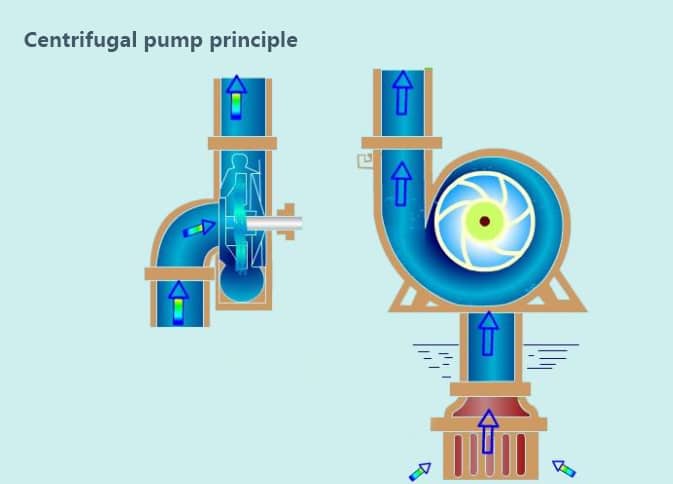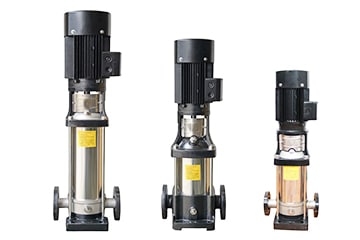Centrifugal Pump Suction And Discharge
Define centrifugal pump
What is a centrifugal pump?
Centrifugal pumps, a common type of power pump, are a type of positive displacement pump, and the most common type of horizontal pump is the centrifugal pump type. It is used to move liquids from a low-pressure area to a high-pressure area by mechanical rotational force. Centrifugal pumps are usually driven by a rotating impeller (also known as a vane or caster), which creates centrifugal force through rotation, causing the liquid to be pumped into the pump and then discharged through the discharge outlet.
Application areas of centrifugal pumps
Centrifugal pumps are pumps that are widely used in various industrial sectors. Because they are process pumps, they are best suited for handling low-viscosity liquids, as they are designed on the principle of fast rotation and high flow rates.
- Water supply and drainage
- Chemical industry
- Oil and gas
- Food and beverage industry
- Pharmaceutical industry
- Sewage treatment
- Paper and mining, industry
What are the main features of centrifugal pumps?
There are two main families of pumps: Centrifugal pumps and positive displacement pumps. Compared to the latter, centrifugal pumps are usually specified for higher flow rates and for pumping lower viscosity liquids (down to 0.1 cP). In some chemical plants, 90% of the pumps used are centrifugal. However, there are many applications where positive displacement pumps are preferred.
Pump Discharge And Suction Process
Inhalation Process
The suction process is the first step in the operation of a centrifugal pump, and the suction inlet is connected to the suction piping, which is the piping that brings the liquid from the source into the pump. The suction piping usually extends to the source of the liquid, such as a pool, well, or other liquid storage facility. During suction, the impeller or vanes of the pump rotate, creating a low-pressure zone that allows liquid to be pumped into the suction line. This low-pressure zone encourages the liquid to flow from the source into the pump. The liquid is sucked into the suction line and subsequently into the interior of the pump. This process continues until the liquid inside the pump reaches a certain preset level.
discharge process
The discharge process of a centrifugal pump is the process of sending the liquid that has been suctioned to the target location through the discharge outlet and discharge piping. This process relies on the centrifugal force generated by the rotation of the impeller and ensures that the liquid is transported efficiently to the desired location. The pump stator usually plays a role in the discharge process. The pump stator is a sealing element, usually located near the pump discharge outlet or pump discharge piping, to prevent the liquid from backing up from the discharge outlet back into the pump, so the pump stator plays a key role in sealing and controlling the flow direction.

Pump Comparison
| Features | Centrifugal Pump | Diaphragm Pump |
| Working principle | Utilizes centrifugal force to push the liquid to the outlet | Pumping of liquids by expansion and contraction of diaphragms |
| Pressure control | High | Adjustable |
| Flow control | Control changes with pump speed | Air pressure controlled flow |
| Liquids pumped | Clean liquids and liquids with low suspended solids | Suspended, viscous and corrosion-resistant liquids |
| Noise level | High | Low |
The choice of centrifugal or diaphragm pumps depends on the requirements of the specific application. Centrifugal pumps are typically used for high-flow, high-pressure applications, while diaphragm pumps are more advantageous when precise flow and pressure control are required and when handling different types of liquids.
Common Failures Of Centrifugal Pump
Common faults in the suction phase
Clogged suction line: Dirt, sediment, or other obstructions in the suction line can reduce the pump’s suction efficiency, resulting in reduced flow.
Leaking suction line: A leak in the suction line may prevent the pump from establishing a sufficient vacuum, reducing the pump’s suction capacity.
Clogged suction strainer: If the centrifugal pump is equipped with a suction strainer, a clogged strainer will reduce the pump’s suction efficiency.
Air leakage into the suction line: Air may enter the suction line and reduce the pump’s suction efficiency.
Common faults during the discharge phase
Clogged discharge line: A buildup of material or clogging in the discharge line may prevent the smooth discharge of liquid.
Impeller damage: Wear or damage to the impeller may result in reduced pump discharge capacity and reduced flow.
Seal leakage: Leakage may occur at the pump seal, resulting in a reduction in the pump’s discharge efficiency.
Internal pump wear: Wear or damage to the pump’s internal parts may result in reduced pump performance.
Centrifugal Pump Suction NPSH Requirement
The NPSH of a centrifugal pump is the pressure energy at the suction end of the pump, which is used to overcome the vaporization and cavitation that occurs during the suction process of the liquid. The correct NPSH value ensures the proper operation of the centrifugal pump, so it is very important to ensure that sufficient NPSH is provided for the use of centrifugal pumps.
- Net positive suction height: The inlet of a centrifugal pump must be higher than the level of the pump inlet, which ensures that the liquid flows naturally to the pump inlet without additional pressure being applied. Therefore, the pump installation position should take into account the difference between the liquid level height and the pump position, and ensure that the net positive suction height meets the design requirements.
- NPSH value: Centrifugal pumps need the net positive suction pressure energy required for normal operation, known as the NPSH value. This value depends on the design and operating conditions of the pump and is usually expressed in meters or kilopascals (kPa). The system supplying the liquid must provide an NPSH value at least equal to or greater than that required by the pump to avoid cavitation.
- Air venting equipment: Gases or vapors may be present in the suction line of the pump that can reduce the pressure energy of the liquid, resulting in reduced pump performance or cavitation. To eliminate these gases, exhaust equipment can be installed in the suction area of the pump to ensure that the fluid at the pump inlet is liquid.
- Suction piping design Design also has an impact on NPSH. Piping should be as straight as possible to minimize the number of elbows and valves. The diameter of the piping should be large enough to minimize the flow rate and friction losses of the fluid through the piping. In addition, the piping should be kept sealed to avoid air ingress.
The vertical multistage pump is a vertical pipeline booster centrifugal pump equipped with a standard vertical motor and assembled mechanical seal. Multi-stage impellers are connected in series, and the inlet and outlet are on the same level. It is the ideal solution for high pressure and low flow.

Summary
The suction and discharge processes are central to the work of centrifugal pumps, and they work in tandem to move liquids from one place to another, allowing for liquid transfer and pressure buildup in a variety of applications.
AOBL provides fluid handling equipment to customers and industries around the world, including electric diaphragm pumps, sanitary pumps, filter press pumps, progressive cavity pumps, chemical pumps, magnetic pumps and other equipment. Welcome to contact us.

